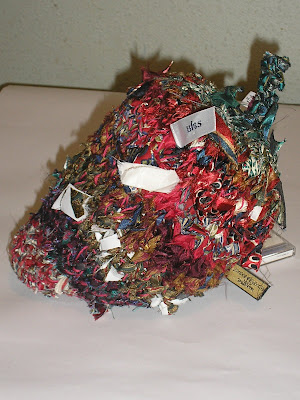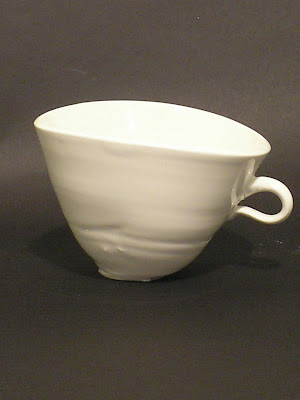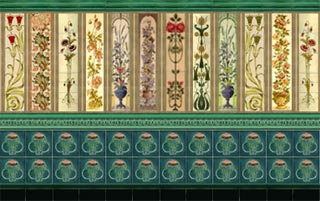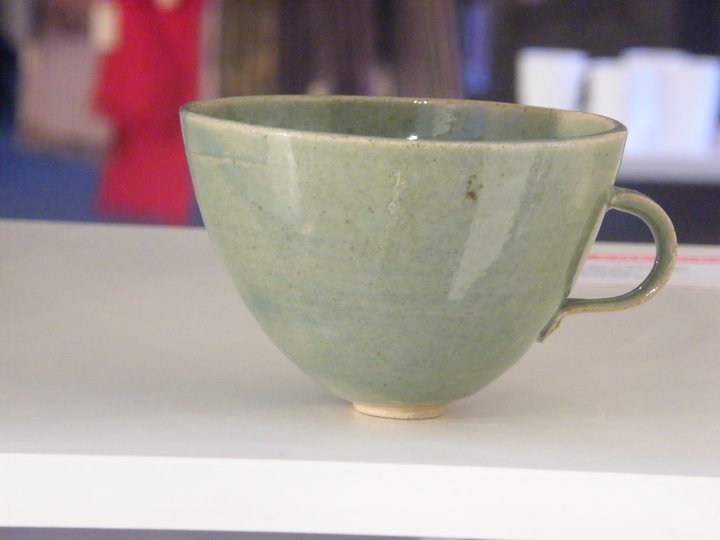This is a knnitted strawberry using recycled cut up ties. This is a test piece for a show about recycling. Its about 14" long.
Pageviews last month
Saturday 28 March 2009
A knitted strawberry
I been knitting again

This is a knnitted strawberry using recycled cut up ties. This is a test piece for a show about recycling. Its about 14" long.
This is a knnitted strawberry using recycled cut up ties. This is a test piece for a show about recycling. Its about 14" long.
Friday 27 March 2009
The Social Life of Things.
The social life of these mugs will include their production sale, use, discard and posible retrieval from an archaeological context.


I have made these cups. As they are a product of craft practice they are expressing something radically different from a mug bought in Sainsburies. I have spent since 2005 learning to throw porcelain so that I have enough skill to produce an object that is a bit more 'articulate' than ones I have made previously. the difference to me shows.
I sold these cups on etsy to a guy in New York- I'm not sure at this moment in time whether he is using them.


I have made these cups. As they are a product of craft practice they are expressing something radically different from a mug bought in Sainsburies. I have spent since 2005 learning to throw porcelain so that I have enough skill to produce an object that is a bit more 'articulate' than ones I have made previously. the difference to me shows.

I sold these cups on etsy to a guy in New York- I'm not sure at this moment in time whether he is using them.
Bruce Mau says.......

"Remember.
Growth is only possible as a product of history. Without memory, innovation is merely novelty. History gives growth a direction. But a memory is never perfect. Every memory is a degraded or composite image of a previous moment or event. That’s what makes us aware of its quality as a past and not a present. It means that every memory is new, a partial construct different from its source, and, as such, a potential for growth itself".
even the memory stick is not perfect but asherd of pot from archaeological context never changes in essence -it will degrade and become physically debrided but its history remains intact. It is testament to all that has gone before. It contains memory or history.
‘the trouble with clay is you can’t store it on a memory stick’.
Don't you just love Victorian Baths


This is a rationale for the harrow ceramics degree course being cut.
Has such a facile statement ever been uttered about this subject.You can't put blood in a a memory stick but that doesn't mean haematology courses are being cut. Its all thanks to materials such as clay that humans are technologically competent, developped the opposing thumb which finally led to our industrial revolution and thus manufacturing silicon chips then to memory sticks. It was one of the first materials humans began to fashion into objects, along with stone/flint, bone, wood. 24000 years ago humans began to make clay objects-silicon chips have only been aroung-say 50 years. Arrogance isn't the word.
This was said by a senior manager about the ceramics degree course at Harrow which has been targeted for being cut out completely. This is an extremely short sighted course of action as the course at Harrow is reputably the best in the country.
http://www.studiopottery.co.uk/news_item.php?id=214
Several Issues are raised by this course of action
Bruce Mau in his Incomplete Manifesto says about making/designing-No 24 "avoid software everyone has it. We need to keep the old technologies alive",
NO 38- "Explore the other edge.Great liberty exists when we avoid trying to run with the technological pack. We can’t find the leading edge because it’s trampled underfoot. Try using old-tech equipment made obsolete by an economic cycle but still rich with potential".No 42 "Remember.Growth is only possible as a product of history. Without memory, innovation is merely novelty. History gives growth a direction. But a memory is never perfect. Every memory is a degraded or composite image of a previous moment or event. That’s what makes us aware of its quality as a past and not a present. It means that every memory is new, a partial construct different from its source, and, as such, a potential for growth itself".
If Westminster University want to produce world class design this type of 3D design is essential to a design culture.
one of the other problems is that we live in a market driven economy. With this recession many people are beginning to reevaluate the rationales for underpinning our education and health systems with these economic infrastructures.
What do business managers know about ceramics, education and health.
one of the percived problems with ceramics courses and why they may be undervalued is that in the west people don't understand the conteporary relevance of clay/ceramic knowledge to the world even though they use ceramic objects everyday of their lives.
For example we would not have sewage or clean water systems but for technological marvels of the Victorian mass produced, salt glazed ceramic pipe. Without this technology the modern world would never have come into existance. yes plasti, stainless steel can now replace this material for certain objects but we all choose to have white porcelain WC's in our loos, ceramic, not plastic tiles on the wall. Ceramics is much more durable. Just think of the senior manager using his loo and not being able to see the relevance of ceramics to the contemporary world. I b et his sewage is fed away in ceramic pipes. And if we ever run out of oil we will again make ceramic pipe for all clean water and sewage systems. London and thus the senior managers job wouldn't have ever come into existence without this ceramic technology. His office is probably right over these 120 year old sewers that still keeps the air fresh in that part of London.This is not a joke I am deadly serious. Without this technology London would never have expanded,given us all our disease free citeies, a model which has been repeated the world over ad infinitum.

Another problem is tht objects are not theorised say like 2D media-Visual Culture Studies or Art History.
Baudrillard has written his System of Objects. Material Cultural studies is an emerging discipline. This is multidisciplinary in nature, including not only archaeology and anthropology, but also sociology, art history, philosophy, psychology and cognitive science. and the there are now deparments and courses devoted to the study of our material world in some of our universities.


This is a rationale for the harrow ceramics degree course being cut.
Has such a facile statement ever been uttered about this subject.You can't put blood in a a memory stick but that doesn't mean haematology courses are being cut. Its all thanks to materials such as clay that humans are technologically competent, developped the opposing thumb which finally led to our industrial revolution and thus manufacturing silicon chips then to memory sticks. It was one of the first materials humans began to fashion into objects, along with stone/flint, bone, wood. 24000 years ago humans began to make clay objects-silicon chips have only been aroung-say 50 years. Arrogance isn't the word.
This was said by a senior manager about the ceramics degree course at Harrow which has been targeted for being cut out completely. This is an extremely short sighted course of action as the course at Harrow is reputably the best in the country.
http://www.studiopottery.co.uk/news_item.php?id=214
Several Issues are raised by this course of action
Bruce Mau in his Incomplete Manifesto says about making/designing-No 24 "avoid software everyone has it. We need to keep the old technologies alive",
NO 38- "Explore the other edge.Great liberty exists when we avoid trying to run with the technological pack. We can’t find the leading edge because it’s trampled underfoot. Try using old-tech equipment made obsolete by an economic cycle but still rich with potential".No 42 "Remember.Growth is only possible as a product of history. Without memory, innovation is merely novelty. History gives growth a direction. But a memory is never perfect. Every memory is a degraded or composite image of a previous moment or event. That’s what makes us aware of its quality as a past and not a present. It means that every memory is new, a partial construct different from its source, and, as such, a potential for growth itself".
If Westminster University want to produce world class design this type of 3D design is essential to a design culture.
one of the other problems is that we live in a market driven economy. With this recession many people are beginning to reevaluate the rationales for underpinning our education and health systems with these economic infrastructures.
What do business managers know about ceramics, education and health.
one of the percived problems with ceramics courses and why they may be undervalued is that in the west people don't understand the conteporary relevance of clay/ceramic knowledge to the world even though they use ceramic objects everyday of their lives.
For example we would not have sewage or clean water systems but for technological marvels of the Victorian mass produced, salt glazed ceramic pipe. Without this technology the modern world would never have come into existance. yes plasti, stainless steel can now replace this material for certain objects but we all choose to have white porcelain WC's in our loos, ceramic, not plastic tiles on the wall. Ceramics is much more durable. Just think of the senior manager using his loo and not being able to see the relevance of ceramics to the contemporary world. I b et his sewage is fed away in ceramic pipes. And if we ever run out of oil we will again make ceramic pipe for all clean water and sewage systems. London and thus the senior managers job wouldn't have ever come into existence without this ceramic technology. His office is probably right over these 120 year old sewers that still keeps the air fresh in that part of London.This is not a joke I am deadly serious. Without this technology London would never have expanded,given us all our disease free citeies, a model which has been repeated the world over ad infinitum.

Another problem is tht objects are not theorised say like 2D media-Visual Culture Studies or Art History.
Baudrillard has written his System of Objects. Material Cultural studies is an emerging discipline. This is multidisciplinary in nature, including not only archaeology and anthropology, but also sociology, art history, philosophy, psychology and cognitive science. and the there are now deparments and courses devoted to the study of our material world in some of our universities.
Monday 23 March 2009
Hundertwasser wasn't mad about maths!!
Realise you must have similar philosophy to Hundertwasser one of my favourite artists who I love not just for his art but for his ideas 2. he believes that "ruler drawn straight lines make people sick because , not occuring in nature, they incessantly subject people to an irritation for which the organism is unprepared.. he believes " we are made up of cells, organically built into humans ... so when these seeing cells percieve something that is alien to them ,alien to organic forms, they transmit an alarm signal to the brain "... Another quote which is hilarious but has an underlying truth is..." if a lion is stalking you, or a shark is out to kill you, you are of course in mortal danger. We have lived with these dangers for millions of years. Tjhe straight line is a man-made danger. There are so many lines , millions of lines,but only oneof themis deadly and that is the straight line drawn with a ruler.. The danger of the straight line cannot be compared with the danger of organic lines made by snakes, forinstance. The straight lineis completely alien to mankind, to life, to all creation"........ nuts
Tuesday 17 March 2009
Happy St. Patrick's Day
I bin out in Plymouth celebrating my irish background- my mother came from Tipperary so I am able to claim a strong irish background. I actually have an ancestor called Black jack Fogaerty who if he is googled comes up with stories and pictures of his castle in Dovea- in tipperary.
my friend Karen grew the Shamrock in her back garden as it is now endangered as a wild species as the bogs shrink.
Saturday 14 March 2009
Some Musings on Material Cultural theory.

We are surrounded by objects but either don't notice them, take them for granted. material culture theorists are starting to say that humans act and think through the objeects that they use. We have a special relationship with specific objects that we use. We have an interdependence with objects.As a result networks of meaning result.
Archaeologists are involved in building bodies of theory using interdiciplinary approaches cognitive science, anthrpology, social theory amongst others.
Ruthanne Tudballs confident, eloquent statement of the possiblites of clay, salt and fire make us notice this object. it is not possible to take a crafted object like this for granted. is this what craft can do? It also seems to bring the networks of meaning to the surface. When you see a teapot like this it is obvious that it is handmade, skill is evident. If I owned a teapot like this I would use it everyday and feel completely different using it in my morning tea rituals.
In Defence of the Handmade
"There are plenty of commercial venues for design and industrial products designed to reference craft are not craft, and are often misleading in our craft ignorant culture. Objects such as these have a wide reach in furniture shops and design venues. Galleries that can showcase the handmade should make an effort to do so with sensitivity towards makers and an understanding of the term "handmade".
So says Shannon Garson, who has also written a very comprehensive artivle-in defence of the handmade pottery-http://www.ceramicstoday.com/articles/home_cooking.htm
Also her blog -Strange Fragments.
She is an articulate and well considered critic against of consumer culture appropriating the handmade rather than actually promoting a real aesthetic of the handmade. www.etsy.com will not allow its shopownes to market something that is obviously not handmade.
Thursday 12 March 2009
Made in Stonehouse, Plymouth, Devon
Just another example of my mugs. They will retail at £25 in a gallery setting. This is a little more expensive than you might pay in Debenhams or Dingles for porcelain but it is possible to know the person who has made these mugs. And although it is possible to mass produce this mug, its very shape is formed by the rotation of the wheel and movement of the hand!!!!!!!!!!!
Made in Plymouth
The recent post by Emmanuel Cooper in Ceramic Review Blog has highlighted an issue about contemporary studio ceramics being undercut by very cheap ceramic imports from the developing economies of the world, sold in cut price shops such as Matalan, T K Max, and the supermarkets. Firstly designs are ripped off from western studio cermics as they are being made for largely western markets. Secondly they are the same as the rag trade, made in sweat shops, With all the division of labour described in a post below. The workers probably earn a dollar a day and would now with a wage like that with food prices having risen can no longer afford to eat. Thus cheap ceramic imports have either airmiles or container miles. Wedgewood as a company has not survived - even the Brish Ceramic companies can not compete against these imports. However, a point I like to make is that, a Winchcombe Teapot, made in Gloucestershire, is competetive in terms of price with the porcelain teapots made in the developping countries, and there are no airmiles on it.
Tuesday 10 March 2009
A Plymouth Pottery
Subscribe to:
Posts (Atom)


